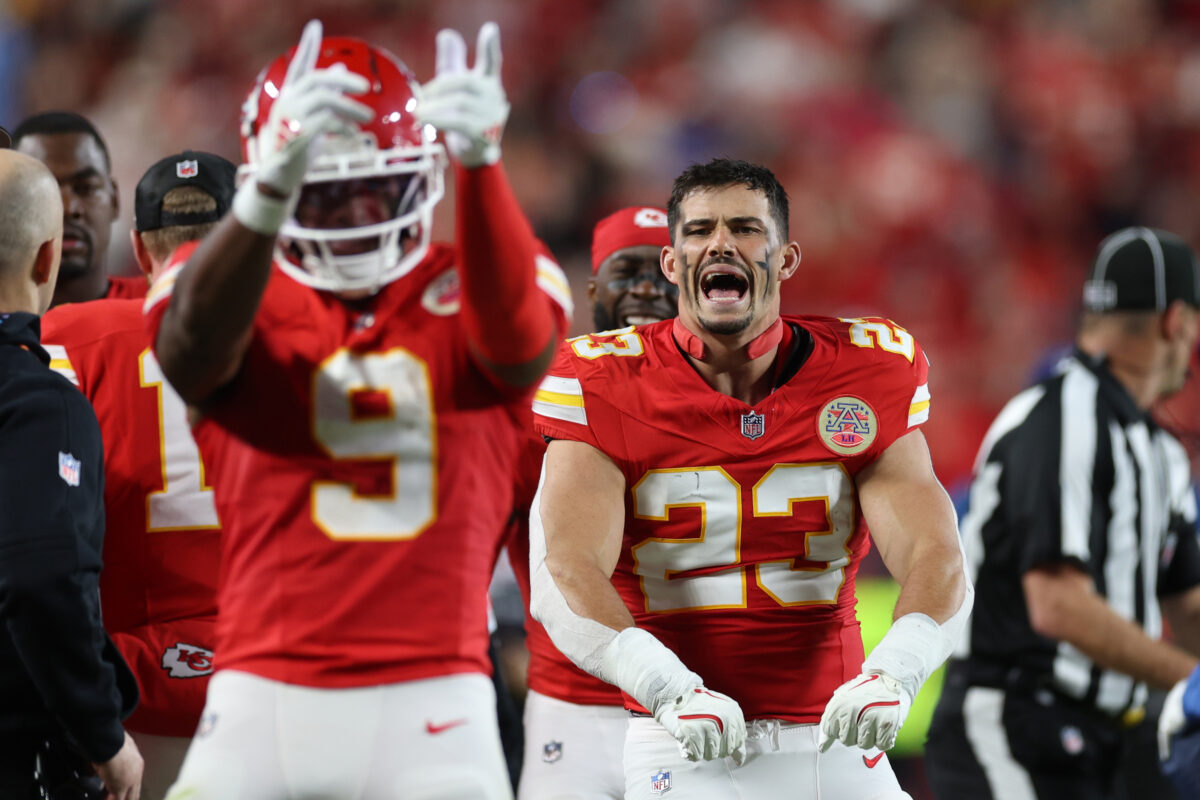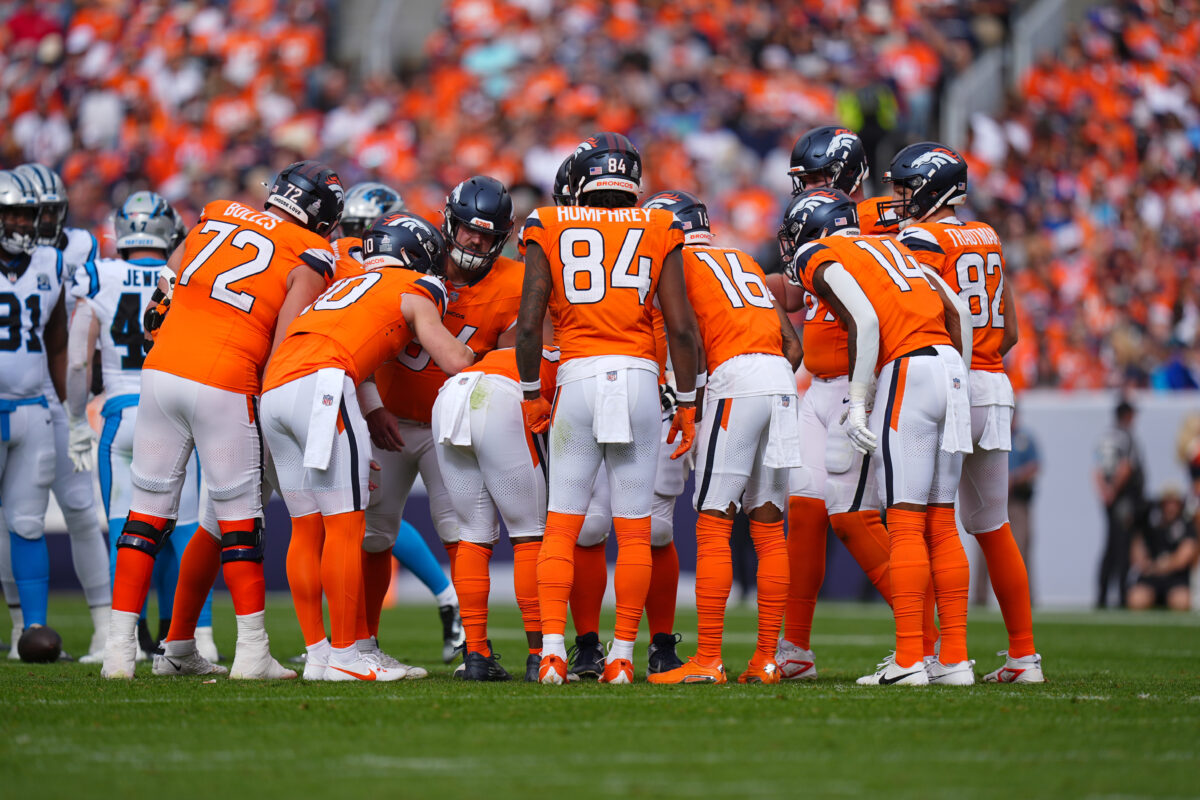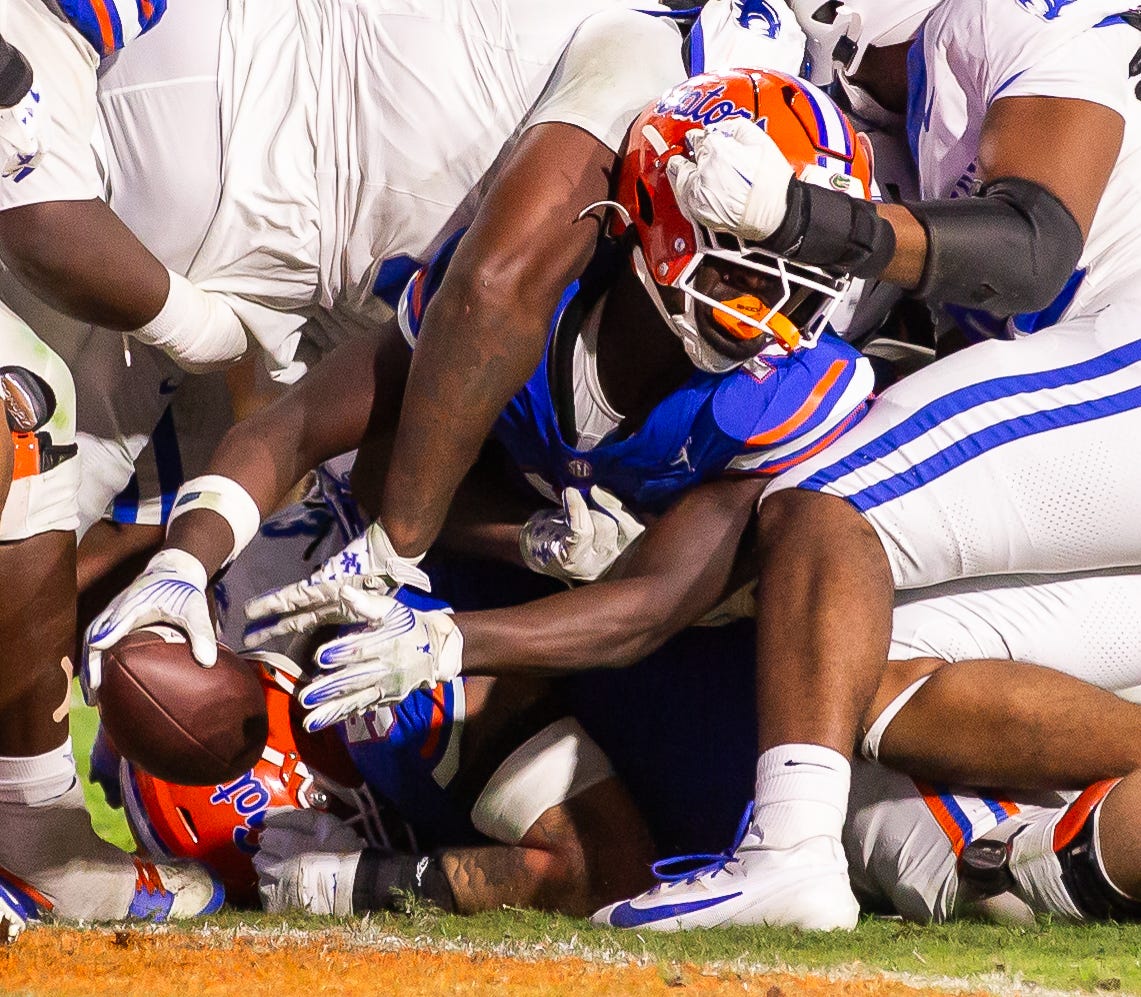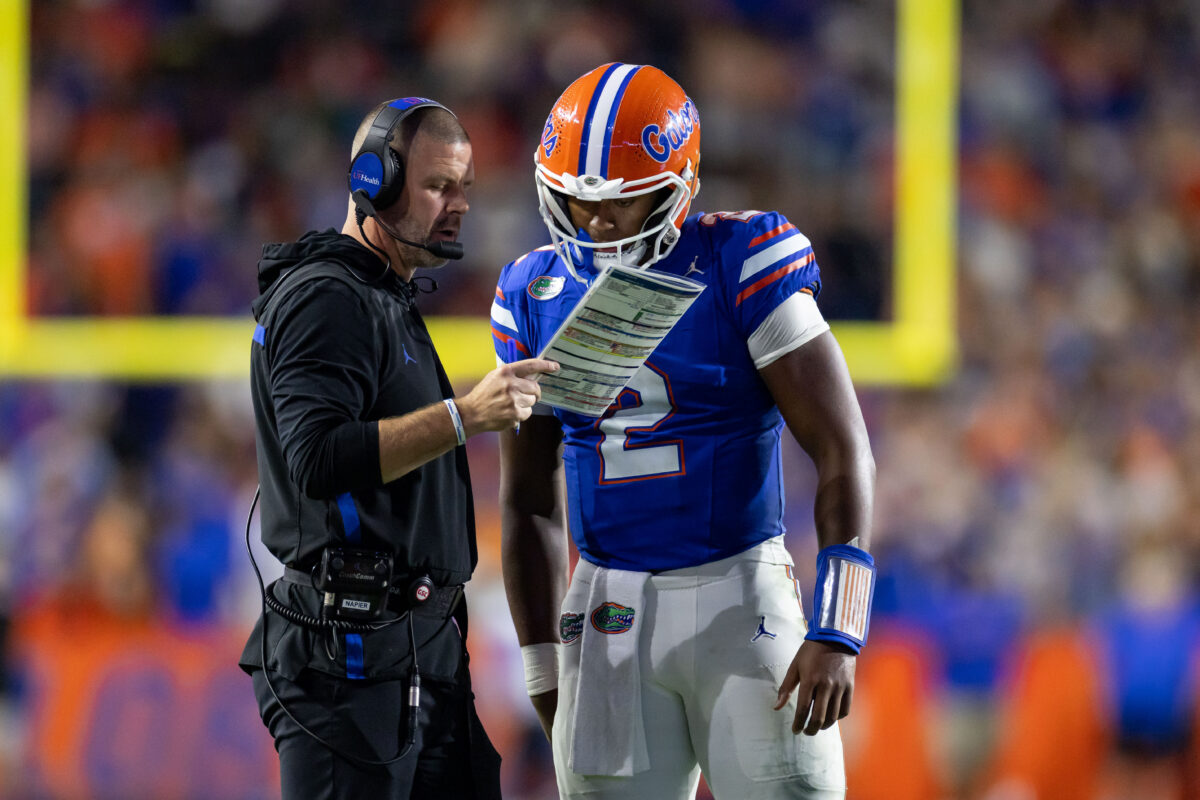Florida’s offense struggled against Tennessee, earning a 63.0 overall team grade from Pro Football Focus in the Week 7 loss.
It’s the lowest grade Florida has earned since Week 3 against Texas A&M (62.9) and is only slightly better than the 58.4 earned in Week 1 against Miami.
Gators Wire breaks down PFF grades each week, splitting the offense into two categories — the passing game and the run game. This article is focused on the passing game, further broken down into three elements — passing, receiving and pass blocking.
For those unfamiliar with PFF’s grading system, a refresher course can be found at the bottom of this page. Let’s get into the numbers.
Quarterbacks
Before discussing the quarterbacks, it’s important to note that starter [autotag]Graham Mertz[/autotag] suffered an injury in the second half that will keep him out for the rest of the season. That doesn’t change how PFF grades his performance, but it does change the emphasis normally placed on his play as the starting quarterback. As a result, [autotag]DJ Lagway[/autotag] will be the main focus this week.
Lagway took 39 snaps to Mertz’s 33 and also dropped back 20 times to the starter’s 18. Mertz led statistically, completing 11 of 15 attempts (73.3%) for 125 yards and a touchdown, while Lagway struggled to find the same consistency. The true freshman completed just nine of 17 attempts (52.9%) for 98 yards, a touchdown and one interception.
Mertz ended the game with the third-best overall grade (72.3) on the team, while Lagway finished with the worst (51.8). The trend continues when looking at the passing grades (removing scrambles and designed runs). Mertz was second with a 76.6 and Lagway was second to last on the list with a 53.1 passing grade. Keep in mind that Mertz had a 24.6 fumble grade, which should have lowered his overall.
Frankly, Lagway’s grades are concerning, even if it comes against one of the top defenses in the country. Florida plays four more ranked teams this year, and it’s going to be difficult winning any of those with a quarterback playing at a replacement level.
He wasn’t as sharp in play action (47.3/47.4) and failed to reach the 65.0 threshold while running any passing concept (no play action, screen and no screen). The silver lining is that Lagway earned a 75.2 on deep plays, connecting with Chimere Dike for a game-tying touchdown late in the fourth quarter.
Lagway ranks sixth in the country with a 95.7 passing grade on deep plays this season; however, it’s important to note that he’s only attempted 12 throws beyond 20 yards.
Receivers
Florida’s 60.2 receiving grade against Tennessee is the worst number the Gators’ pass-catchers have put up all season, narrowly beating out a 60.3-grade performance against Texas A&M.
Slot
[autotag]Chimere Dike[/autotag]’s role in Florida’s offense has changed throughout the season. He lines up both in the slot and out wide, typically on the left side. He’s been slot-heavy for the past two games, but Eugene Wilson III’s return to action allows Dike to move out wide a bit more often.
Against Tennessee, Dike played 51 of 72 offensive snaps, lining up in the slot 23 times and out wide 27 times. Pro Football Focus has him listed as a slot receiver, so that’s the designation we’ll go with, but know that Dike is a multi-faceted threat, similar to Ricky Pearsall and Wilson.
Dike led the receivers room with a 64.5 overall offensive grade and a 63.9 receiving grade. He caught four of six targets for 76 yards and the game-tying touchdown mentioned above. A fumble led to a fumble grade of 23.4, hurting the other two grades, but this was a pretty solid performance from Dike in a different role than usual.
Instead of being targeted behind the line of scrimmage and within 10 yards, the majority of Dike’s routes and targets went beyond the first-down marker.
Left WR
It’s hard to pin down [autotag]Eugene Wilson III[/autotag]’s position since he plays all over the field on offense. Wilson took the field for 57 of 72 offensive snaps, lining up 29 times out wide and 27 times in the slot — 15 on the left and 14 on the right. PFF calls him a left wide receiver, so that’s what we’ll go with.
He led the team with five catches on eight targets but only collected 35 yards. His average depth of target was only 5.4 yards, which means he’s running a lot of drags and screens.
Wilson’s overall grade of 56.9 and receiving grade of 58.1 aren’t great, but his drop grade of 76.3 was the highest on the team. Hopefully, the second-year Gator is able to find his rhythm and make a bigger impact in the passing game moving forward. His best numbers came in the intermediate range (72.5), so look for Billy Napier to utilize him a bit differently next week.
Right WR
[autotag]Elijhah Badger[/autotag] is also listed as a left wide receiver, but he actually lined up on the right side 30 times to 21 on the left. Badger played 58 of 72 offensive snaps, the most of any Florida receiver this week. He caught two of four targets for 30 yards — his lowest single-game total of the year.
His 57.6 overall grade and 59.4 receiving grade are also season lows, which might have to do with Wilson’s return. Still, it’s surprising to see Badger finish without a deep-ball catch, considering Florida receivers performed best against Tennessee strong safety Andre Turrentine (31.7 coverage grade).
[autotag]Aidan Mizell[/autotag] was the fourth receiver to get snaps, splitting time on either side out wide. He was only targeted once and played all of five snaps when Florida called a passing play. His 55.6 overall grade and 55.5 receiving grade should be taken with a grain of salt.
Tight Ends
Florida’s tight-end tandem of [autotag]Arlis Boardingham[/autotag] and [autotag]Hayden Hansen[/autotag] played a prominent role in the passing game this week. Hansen sees the field more, playing 59 snaps to Boardingham’s 47, but Boardingham played more passing downs (24) than Hansen (19).
Both players hauled in three passes for 40 yards; however, Boardingham scored a touchdown and dropped a pass. As a result of Boardinham’s drop grade (40.2), Hansen finished with a better receiving grade — 76.7 to Boardingham’s 58.7.
Running Backs
It wasn’t a great receiving week for the running backs, but that’s not their primary job. Montrell Johnson Jr. caught one of two targets for eight yards and a 44.1 receiving grade, while Jadan Baugh and Ja’Kobi Jackson both finished the game with negative yardage.
Johnson also got hurt in this game, so let’s just pretend these numbers don’t matter.
Pass Blocking
Florida’s pass-blocking grade is usually the high point of these reviews, but a 76.6 team grade is the second-lowest of the season for the Gators. It’s still a solid number, but there’s no doubt that Florida faced a tough pass rush this week.
As usual, we will go over the offensive line from left to right. Remember, we’re looking at pass-blocking grades only here.
Left Tackle
[autotag]Austin Barber[/autotag] played all 72 snaps and 38 pass plays for Florida against Tennessee, earning an overall grade of 56.3 and a pass-blocking grade of 69.4.
Barber didn’t have his best day as a pass-blocker, slipping under the 70.0 threshold to 69.4 but it was still a solid performance. His overall grade suffers from a relatively poor day as a run blocker.
The only sack of the day for Tennessee came against Barber, which also accounts for his lone allowed quarterback pressure.
Left Guard
[autotag]Knijeah Harris[/autotag] played the majority of snaps at left guard for Florida this week, seeing the field for 64 snaps to Bryce Lovett’s eight. Both players performed well, though.
Harris finished second on the team with an overall grade of 72.7 and he was the team’s best pass blocker with an 86.1 grade. It’s the third game in a row that Harris has earned a pass-blocking grade of 84.6 or higher, and he’s approaching a top-50 berth among guards throughout all of Divison I football with 150 or more snaps.
Lovett had the fourth-highest overall grade (69.0) on offense on the team this week and was third among pass blockers (78.1) in his limited time on the field. He’s been consistent all year in that regard, ranking seventh overall (89.6) among guards, regardless of snap count.
Center
[autotag]Jake Slaughter[/autotag] provided his first poor pass-blocking game of the season, earning a 58.7 pass-blocking and a 53.4 overall grade. It’s pretty easy to figure out where things went wrong. Slaughter allowed three pressures, three hurries and one quarterback hit. A penalty late in the game also hurts.
It’s not time to worry about him just yet, though. Slaughter remains a top-10 pass-blocking center overall and Tennessee is a team that typically gets to the quarterback. He’ll need to clean things up against Kentucky next week.
Right Guard
Damieon George Jr. delivered the worst pass-blocking performance (51.5) of the week and was on the field for 32 passing plays. He’s been on a downward spiral recently, dropping from a low-80s average to below the 65.0 threshold.
Allowing three pressures by UCF last week made for a worse score, but it’s hard to defend this kind of play over back-to-back weeks, especially when Kamryn Waites shows more promise as a pass blocker.
Waites has only played 22 passing snaps over the past three games, but he’s consistently above the 75.0 mark, posting a 75.8 this week. Limited sample size is going to play a factor here, but he was also good against Texas A&M (88.3) when he played 22 snaps in one game.
Right Tackle
Brandon Crenshaw-Dickson has been incredibly steady since becoming a starter in Week 2. He’s consistently at or above 80.0 as a pass blocker and is ranked 13th overall among tackles with at least 150 snaps this year.
It was a rough week for the offensive line, but it’s good to see someone stay consistent against a good pass rush.
Understanding PFF grades
The grading scale ranges from minus-2 to plus-2 with increments of 0.5, and players are given a grade on every play they are on the field for. A zero grade means a player did his job, while the two ends of the scale represent extreme success or failure — think red zone interception at the end of a game or a game-winning touchdown pass when applying it to quarterbacks.
There’s a level of subjectivity to it, but each grade is reviewed at least once. Once all plus-minus grades are in, the numbers are converted to a 0-100 scale to easily compare players. There are some loosely defined tiers within the system — 90-100 is elite, 85-89 is Pro Bowl level for NFL players, 70 to 84 is a starter and 60-69 is a backup. Anything 59 and below is considered a replaceable talent.
Since we’re looking at college athletes with a system designed for the pros, we will consider anything above 65.0 as a solid performance.
Follow us @GatorsWire on X, formerly known as Twitter, and like our page on Facebook to follow ongoing coverage of Florida Gators news, notes and opinions.



